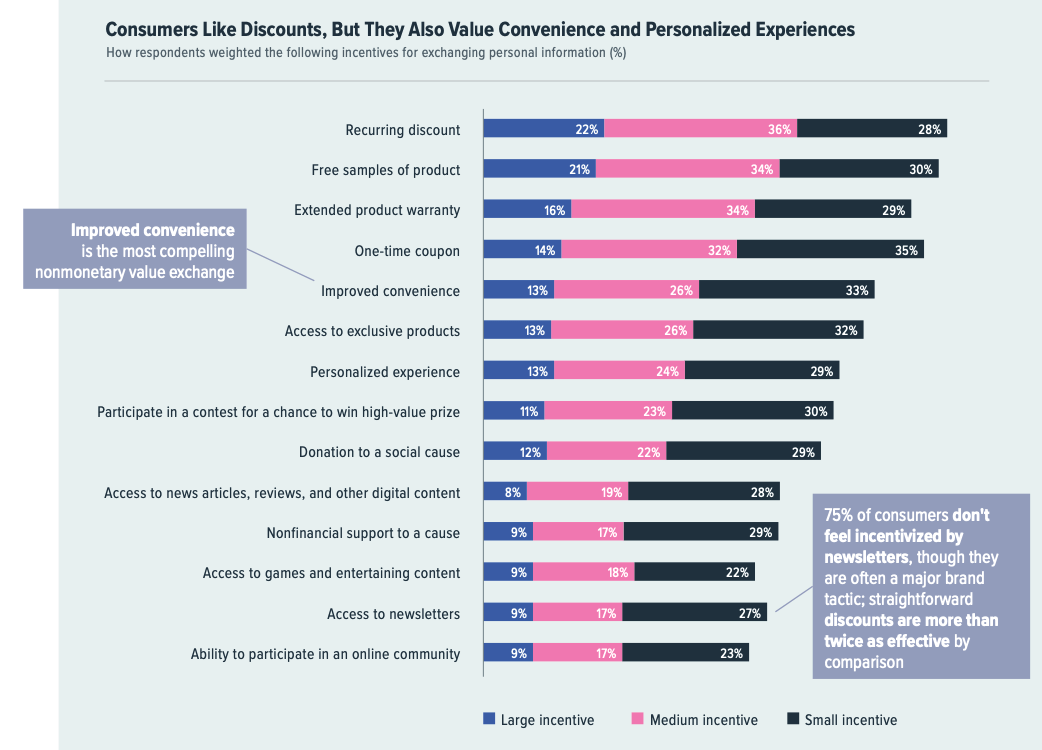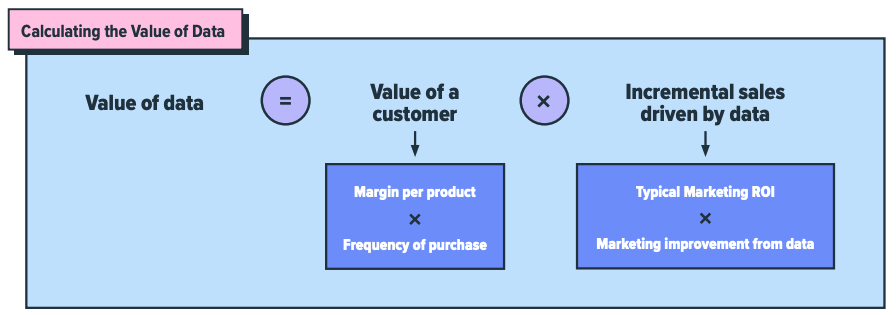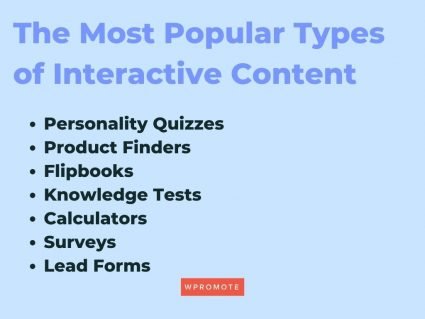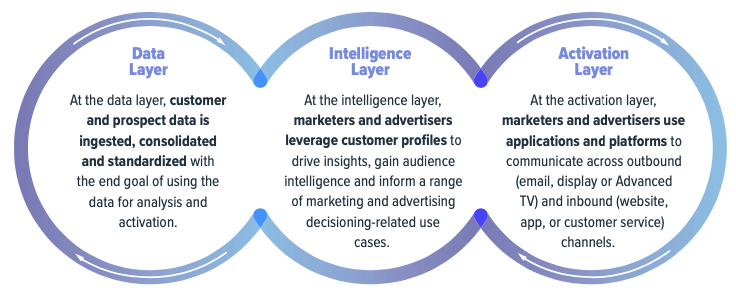Despite dire warnings that marketers need to change their ways when it comes to data or face the consequences, too many businesses are failing to actually commit to the long-term solution for their woes: a mature strategy for collecting and utilizing first-party data.
Whether or not you choose to acknowledge and/or act on it, the ‘cookieapocalypse’ is here. A stubborn reliance on third-party data will have devastating consequences for your bottom line and future growth, but first-party data offers a future-proof way of getting the information you need to drive performance while still protecting user privacy.
A strong first-party data strategy should be based on a mutual exchange of value with users: you’ll need to earn your customers’ data if you want to maintain and grow your marketing impact in the future.
To make this essential switch and scale your first-party data stockpile, you need to go to the upper funnel to make the case to consumers for sharing information, which requires investing in content and campaigns that speak to a broader swath of your prospective audience.
Those campaigns should also offer something in exchange for data that not only provides value to the consumer but helps them build a relationship with your brand; after all, we’re still marketers who want to get results.
Let’s explore what a full-funnel first-party data machine looks like and what it could do for your business.
Why your first-party data collection strategy needs to start in the upper funnel
Point-of-transaction offers such as discounts, coupons, and freebies are popular ways marketers incentivize a user to share information. But if you’re only capturing data at the purchase point, you’re missing out on the bigger picture and will find it extremely difficult to scale your data stockpile enough to wean your business off of the dreaded cookie and platform identity dependency.
You need to build a full-funnel first-party data strategy that sets your business up to win the long game by finding different things you can offer consumers they actually want beyond promotional offers.
A recent survey by Boston Consulting Group found that a one-time coupon was far less effective than a recurring discount and on par with non-monetary value exchanges like improved convenience and personalized experiences. These active value exchanges that aren’t centered around an immediate purchase don’t just maximize your first-party data stockpile, they help your brand build longer-term relationships with customers and prospects.

Source: Boston Consulting Group
The study also notes that common marketing tactics like newsletters no longer hold much appeal for consumers, despite marketers’ long-lived commitment to them, which continues to this day.
You can keep newsletters and coupon codes as part of your arsenal, but they’re not sufficient. Customers want more if they’re going to share their data, and your business needs to collect data at scale. It’s up to you to get creative around what you’re offering and make sure it’s fulfilling your side of that mutual exchange of value while engaging the consumers that matter to your business.
Make the case for investing in first-party data collection by leveraging customer lifetime value
These kinds of interactive, personalized experiences cost money to develop and promote. To secure the necessary budget, you need to be able to articulate the value that data is bringing to the business.
That’s when we turn to customer lifetime value (LTV), which can help you understand the full value of different customer segments to the business over the entire course of their relationship with your brand. This is especially important when you’re making the case for investment in data collection-focused campaigns that aren’t tied directly to revenue.
You need to be able to answer some important questions, especially if your business is traditionally performance-focused. For example: if you know that the average lifetime revenue generated by a user is $150, is your business willing to spend $50 to acquire someone’s email address?
We love Boston Consulting Group’s formula for establishing the relationship between customer lifetime value and incremental sales driven by data. This simple math problem will help you assign an actual dollar amount to the value of your data and give you a better understanding of which data points you actually use and what they’re worth.

Source: Boston Consulting Group
These numbers should help you get the green light from executives on the budget you need to start testing data collection strategies and launching campaigns.
One of the most effective strategies for upper-funnel data collection is interactive content.
How to collect first-party data by building engaging user experiences with interactive content
Quick definition: Interactive content refers to any type of content that requires active engagement. Users become an integral part of a dynamic two-way experience with the brand through clicks, taps, or swipe-throughs instead of just consuming content passively.
Think about interactive content as the way to balance function and value in your mutual exchange of value: customers want data transparency and value, while your business wants data and the opportunity to build a relationship with the customer that drives them down the funnel later.
One of the biggest benefits of interactive content is how clear that value exchange is: users provide information of some kind, and the brand generates results of some kind. And it also serves up a great customer experience and engagement with a brand.
To build great interactive content that strikes the right balance, start with these steps:
- Identify the right stakeholders: You need the right people at the table to figure out how to provide a great experience that drives value for customers and collects the right data. Planning should include both performance marketers who can weigh in on the data they need to execute future campaigns and drive growth and content experts who provide insights into the needs of the customer and how to deliver against them in the upper funnel. Additional stakeholders from product, sales, or other teams might also be involved if the content is linked to bigger business objectives or initiatives.
- Set shared objectives: Your cross-functional team needs to be aligned around what you’re trying to achieve with your interactive content. Besides first-party data collection, which of the following objectives are important to your goals: Brand awareness? Prospecting? Lead generation? Retention? Goals help keep the content focused and ideation around topics and questions on track. Then figure out how you’re evaluating success. That might include a mixture of data-focused KPIs such as audience attributes collected, upper funnel metrics like engagement and completion rates, or direct response metrics like revenue and assisted conversions, depending on the objective.
- Figure out what kind of content you’re making: Your new interactive content needs to deliver on those shared goals and get you the type of data you need. When you’re deciding what you’re building, consider not just what you want from the content, but what will best fit your subject and brand. What kind of experience do you want to build, and how does that align with your wider objective?

- Promote your content: Interactive content distribution requires leveraging multiple channels and should include paid media amplification to get enough data to be useful in your future marketing efforts. Ultimately, the main goal of your distribution strategy is to build out segments based on the information you gather that include a minimum of 5,000-10,000 people. Ideally, each cohort should contain between 25,000-200,000 people for optimal use in future direct response paid media campaigns.
- Prepare to use your data: Make sure you’re set up to actually receive and use the data once you have it. From your CRM, audience segments that have reached the 5-10k person minimum should be piped back into your paid media channels. Based on the new data generated from the interactive content, you can start serving these segments more targeted ads utilizing creative and messaging that mimic the interactive content experience.
Unleash the power of your first-party data
The best thing about privacy-compliant first-party data that your company actually owns is that you have a lot more options when it comes to utilization. Bringing it all together in one single source of truth unlocks intelligence: you can combine your new data with third-party insights and information collected from other first-party sources to generate additional insights. Then your paid media teams can translate that intelligence into business growth by activating more effective, personalized campaigns in your marketing channels driven by audience segmentation.

Source: Winterberry Group
That should be the model for your future marketing: privacy-compliant, data-driven, and built to drive both better customer experiences and business growth.
Investing in a full-funnel first-party data strategy is crucial to the future success of your business. An alarming number of businesses are still sticking with the status quo and aren’t prepared for the first-party data world that’s already very close to reality. Prioritize building a sophisticated data strategy now instead of trying to play catch up later; you’ll gain a significant advantage over the competition that is still burying its head in the sand. As data restrictions tighten – and they will – you will be ready.
Download the full guide to learn how to gain The First-Party Data Advantage: How to Use Interactive Content to Future-Proof Your Marketing Performance.







Responses